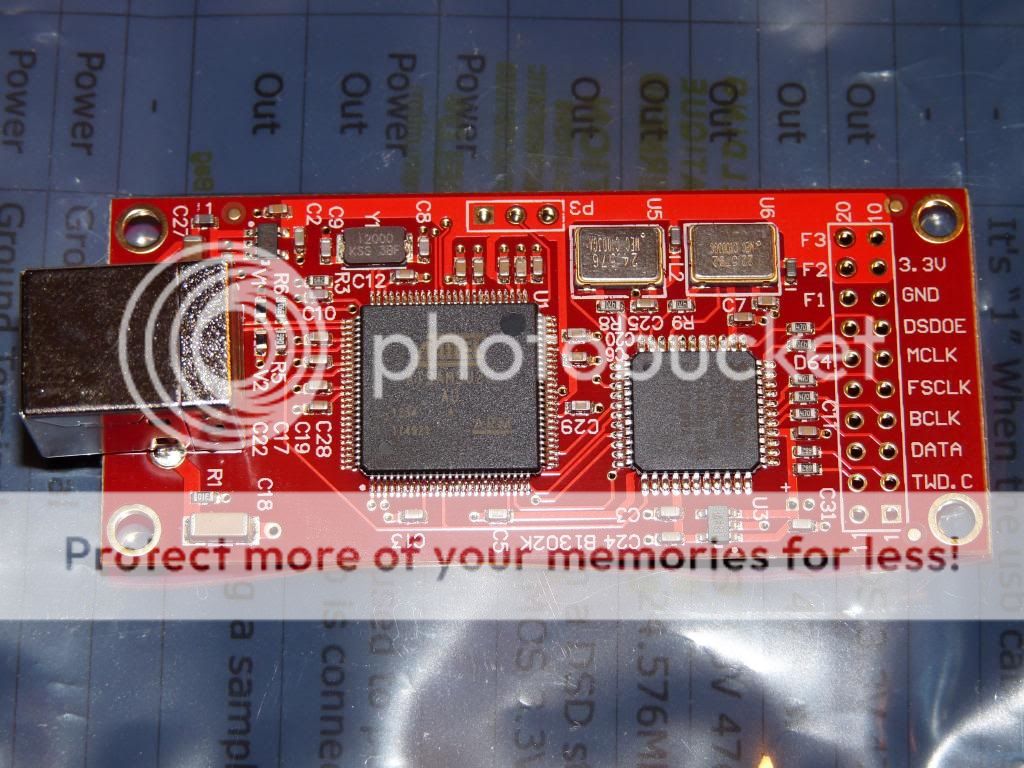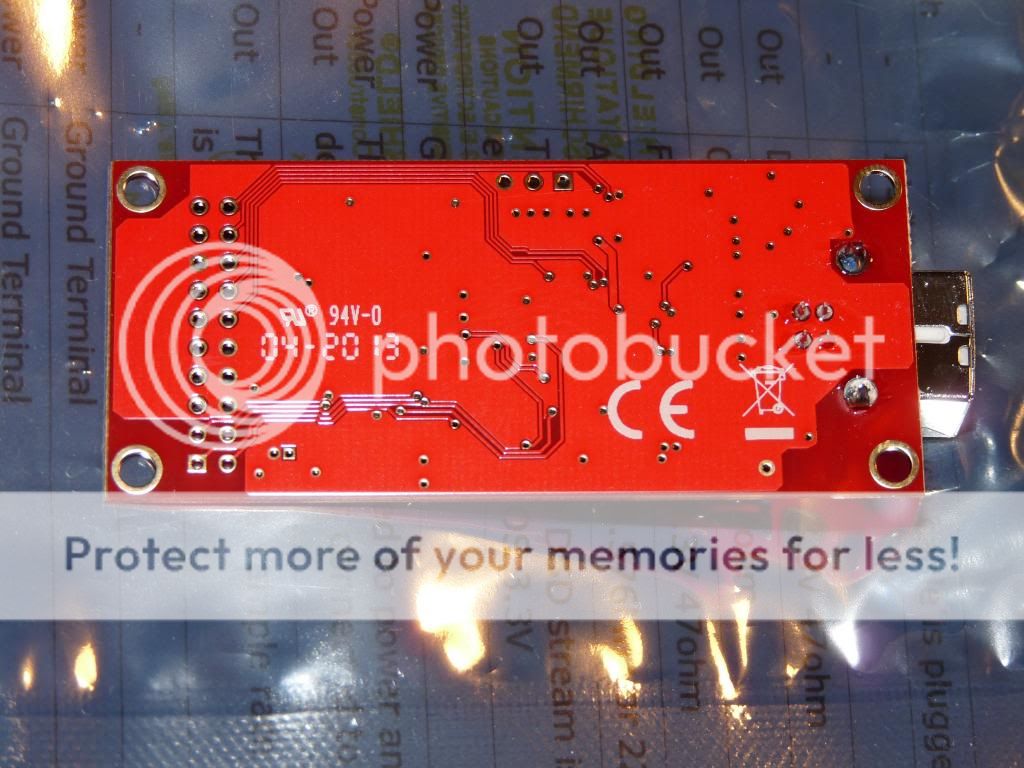Thanks for the pic!
BTW, firm 1.080 is available through the tool. It fixes pin 11 as XO selector, it didn't work in 1.079
BTW, firm 1.080 is available through the tool. It fixes pin 11 as XO selector, it didn't work in 1.079
Today i received mine and here you see what pins are used for the F0,F1,F2 and F3.

And the back.

Thank you Domenico for your nice product.
Best regards George
From the images posted it's obvious that F0 - F3 are pins 17-20 and pin 16 is labeled D64 and that should be latest rev. board. So, be very careful with Acko reclocker boards because it's not fully compatible with this rev. One should remove connections - header pins on these positions to avoid connecting them to ground.
hello, the lines are in sequence D64 (F0) F1 F2 F3
They are open collectors and you can ground them when not used.
They are open collectors and you can ground them when not used.
hello, the lines are in sequence D64 (F0) F1 F2 F3
They are open collectors and you can ground them when not used.
We have schematic for old revision (which I have) but which IC pins were used for D64,F0-F3? Only F3 and F2 lines are clearly visible on the images.
hello, the lines are in sequence D64 (F0) F1 F2 F3
They are open collectors and you can ground them when not used.
Thank you Domenico. You have exceeded all expectations!
Revision B1203K
http://www.amanero.com/USB_E.pdf
http://www.amanero.com/CPLD_E.pdf
http://www.amanero.com/drivers/combo384-D4.pdf
Schematics with F0,...
Thank you!
Domenico
http://www.amanero.com/USB_E.pdf
http://www.amanero.com/CPLD_E.pdf
http://www.amanero.com/drivers/combo384-D4.pdf
Schematics with F0,...
Thank you!
Domenico
Data Sheet
Thanks Domenico.
This extract from the data sheet may stop people reading any further-
"The module works in Master Mode Only, it means that it doesn't accept an external clock in.
input."
http://www.amanero.com/USB_E.pdf
http://www.amanero.com/CPLD_E.pdf
http://www.amanero.com/drivers/combo384-D4.pdf
Schematics with F0,...
Thank you!
Domenico
Thanks Domenico.
This extract from the data sheet may stop people reading any further-
"The module works in Master Mode Only, it means that it doesn't accept an external clock in.
input."
Hi, maybe now it's time to remove the assertion! It's always a Master Mode but with external oscillator ( in the configtool, it's improperly defined slave mode )
thank you
domenico
thank you
domenico
Last edited:
Hi,
my card works very well with Windows but I have some problems with a Linux configuration (and a beaglebone card).
Here's the problem log (i think) on an arm ubuntu 13.04 :
ALSA sound/usb/mixer.c:1303 usb_audio: [10] FU [Combo384 Amanero Playback Volume] ch = 2, val = -32767/0/1ALSA sound/usb/mixer.c:1299 usb_audio: Warning! Unlikely big volume range (=32767), cval->res is probably wrong.
The output is louder than windows and noisy (it's like a crappy vinyl record 🙂 ).
May someone please tell me if a arm linux distribution or a kernel version works better ? (or something to pay attention to )
Thanks.
my card works very well with Windows but I have some problems with a Linux configuration (and a beaglebone card).
Here's the problem log (i think) on an arm ubuntu 13.04 :
ALSA sound/usb/mixer.c:1303 usb_audio: [10] FU [Combo384 Amanero Playback Volume] ch = 2, val = -32767/0/1ALSA sound/usb/mixer.c:1299 usb_audio: Warning! Unlikely big volume range (=32767), cval->res is probably wrong.
The output is louder than windows and noisy (it's like a crappy vinyl record 🙂 ).
May someone please tell me if a arm linux distribution or a kernel version works better ? (or something to pay attention to )
Thanks.
Hello!
What does "DSD Channels Swap"? This will disable the ability to output DSD for not supporting devices?
And the question on the pin of 1. When the generator is 22.5792 it is set to 1 and 0 to 24.576?
1,7,11,16 pin electrically isolated?
What does "DSD Channels Swap"? This will disable the ability to output DSD for not supporting devices?
And the question on the pin of 1. When the generator is 22.5792 it is set to 1 and 0 to 24.576?
1,7,11,16 pin electrically isolated?
Still make Pop noise
Hello.
The pop noise when changing PCM to DSD mode were became small by update of the firmware, but, on the other hand, a pop noise came to appear between DSD to DSD file .
The noise did not come out in the old version.
Amanero-san.
I hope that the problem is recovered by the next version up.😉
By the way , Can I get firmware of oid version ?
thx
Hello.
The pop noise when changing PCM to DSD mode were became small by update of the firmware, but, on the other hand, a pop noise came to appear between DSD to DSD file .
The noise did not come out in the old version.
Amanero-san.
I hope that the problem is recovered by the next version up.😉
By the way , Can I get firmware of oid version ?
thx
Hi all,
A possibly quick question: One of you know if the Amanero board's 512*fs DSD capability works for both 22.579 & 24.576 MHz sample frequencies?
Thanks for any insights you may have ;-)
Jesper
A possibly quick question: One of you know if the Amanero board's 512*fs DSD capability works for both 22.579 & 24.576 MHz sample frequencies?
Thanks for any insights you may have ;-)
Jesper
Hi all,
A possibly quick question: One of you know if the Amanero board's 512*fs DSD capability works for both 22.579 & 24.576 MHz sample frequencies?
Thanks for any insights you may have ;-)
Jesper
Yes it does though I'm not aware of any readily available DAC ICs that support higher than DSD256 and then not all of these support 48K based DSD256.
- Home
- Vendor's Bazaar
- USB to I2S 384Khz - DSD Converter